Billabong International's Strategic Processes and Challenges Analysis
VerifiedAdded on 2021/06/14
|18
|4250
|22
Report
AI Summary
This report provides an analysis of Billabong International's expansion across international borders, focusing on its strategic processes and challenges. The company's journey from its origins on the Gold Coast to its global presence is examined, including its diversification through acquisitions and its adaptation to market trends. The report highlights the company's strategies in the Asian market, particularly in China and Japan, and the implementation of global initiatives such as Omni-channel, global sourcing, and distribution and logistics. Furthermore, the report discusses the EPRG framework, analyzing Billabong's approach to internationalization and the impact of direct operations on marketing and revenue. The analysis includes discussion of the company's financial difficulties, strategic actions taken, and the growth of its brands. The report also explores the company's internationalization process, including its expansion into Japan and the acquisition of brands such as Von Zipper and Element, emphasizing the evolution of the company's strategies and the challenges faced in a dynamic global market. The report provides a comprehensive overview of Billabong's international business operations and strategic decisions.
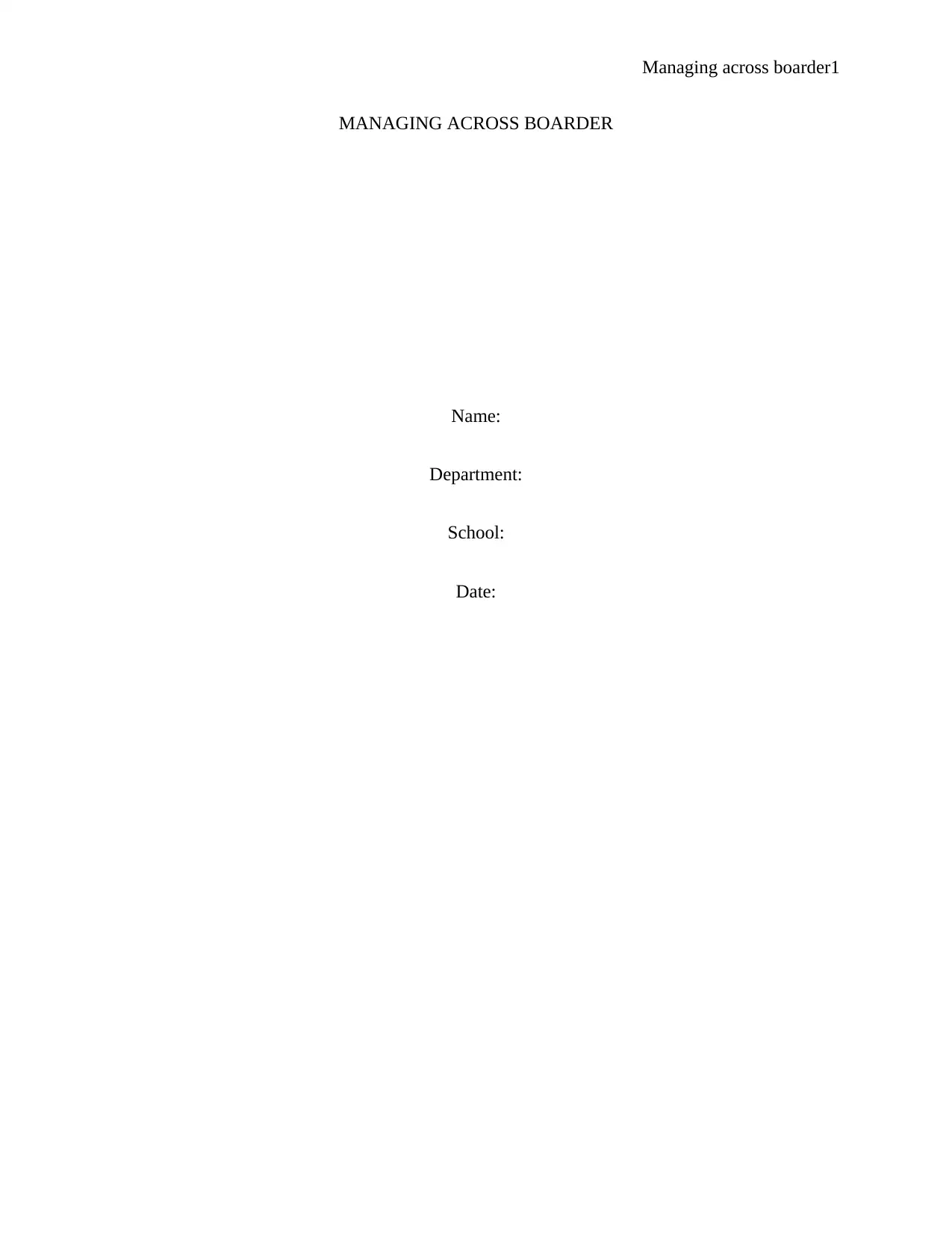
Managing across boarder1
MANAGING ACROSS BOARDER
Name:
Department:
School:
Date:
MANAGING ACROSS BOARDER
Name:
Department:
School:
Date:
Paraphrase This Document
Need a fresh take? Get an instant paraphrase of this document with our AI Paraphraser
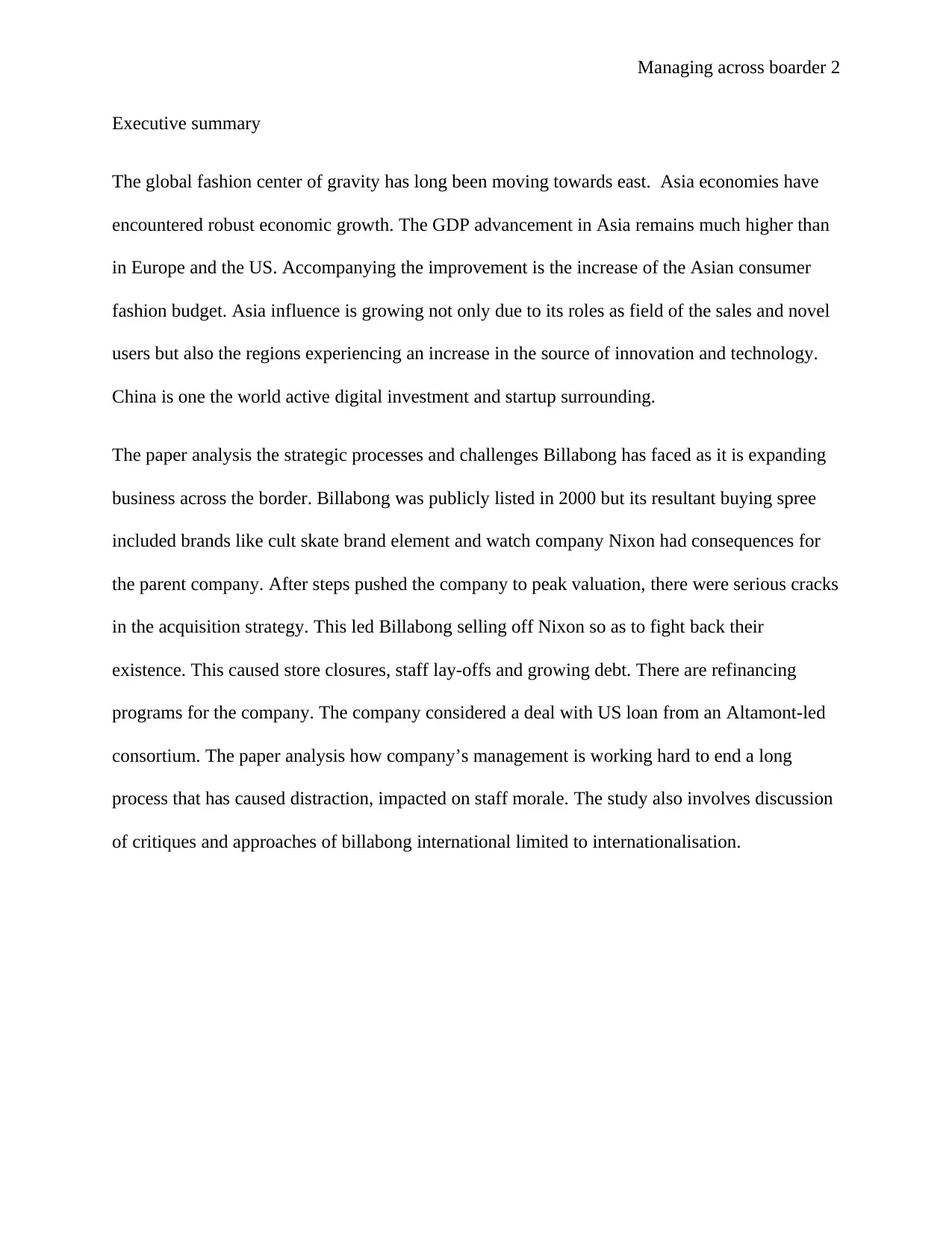
Managing across boarder 2
Executive summary
The global fashion center of gravity has long been moving towards east. Asia economies have
encountered robust economic growth. The GDP advancement in Asia remains much higher than
in Europe and the US. Accompanying the improvement is the increase of the Asian consumer
fashion budget. Asia influence is growing not only due to its roles as field of the sales and novel
users but also the regions experiencing an increase in the source of innovation and technology.
China is one the world active digital investment and startup surrounding.
The paper analysis the strategic processes and challenges Billabong has faced as it is expanding
business across the border. Billabong was publicly listed in 2000 but its resultant buying spree
included brands like cult skate brand element and watch company Nixon had consequences for
the parent company. After steps pushed the company to peak valuation, there were serious cracks
in the acquisition strategy. This led Billabong selling off Nixon so as to fight back their
existence. This caused store closures, staff lay-offs and growing debt. There are refinancing
programs for the company. The company considered a deal with US loan from an Altamont-led
consortium. The paper analysis how company’s management is working hard to end a long
process that has caused distraction, impacted on staff morale. The study also involves discussion
of critiques and approaches of billabong international limited to internationalisation.
Executive summary
The global fashion center of gravity has long been moving towards east. Asia economies have
encountered robust economic growth. The GDP advancement in Asia remains much higher than
in Europe and the US. Accompanying the improvement is the increase of the Asian consumer
fashion budget. Asia influence is growing not only due to its roles as field of the sales and novel
users but also the regions experiencing an increase in the source of innovation and technology.
China is one the world active digital investment and startup surrounding.
The paper analysis the strategic processes and challenges Billabong has faced as it is expanding
business across the border. Billabong was publicly listed in 2000 but its resultant buying spree
included brands like cult skate brand element and watch company Nixon had consequences for
the parent company. After steps pushed the company to peak valuation, there were serious cracks
in the acquisition strategy. This led Billabong selling off Nixon so as to fight back their
existence. This caused store closures, staff lay-offs and growing debt. There are refinancing
programs for the company. The company considered a deal with US loan from an Altamont-led
consortium. The paper analysis how company’s management is working hard to end a long
process that has caused distraction, impacted on staff morale. The study also involves discussion
of critiques and approaches of billabong international limited to internationalisation.
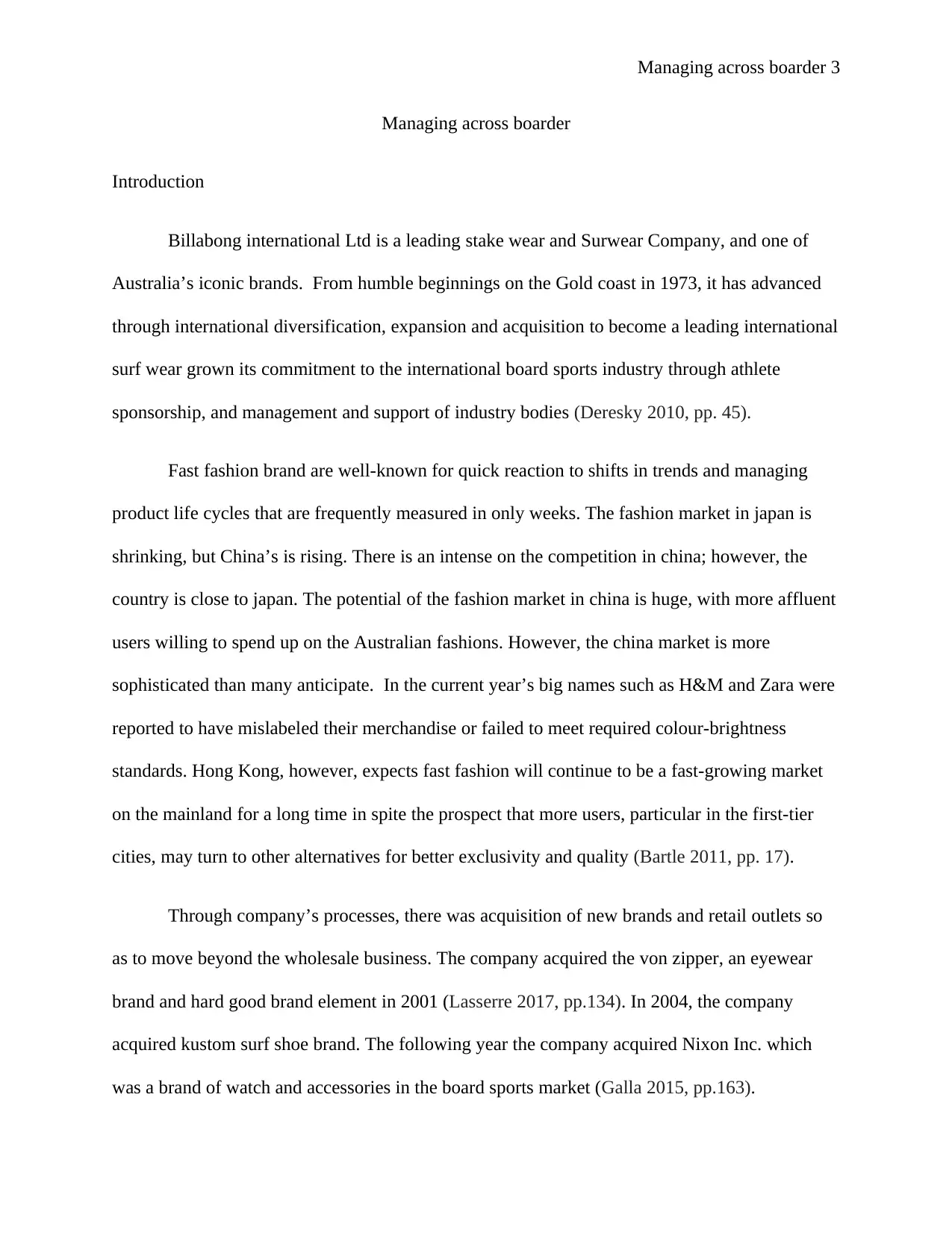
Managing across boarder 3
Managing across boarder
Introduction
Billabong international Ltd is a leading stake wear and Surwear Company, and one of
Australia’s iconic brands. From humble beginnings on the Gold coast in 1973, it has advanced
through international diversification, expansion and acquisition to become a leading international
surf wear grown its commitment to the international board sports industry through athlete
sponsorship, and management and support of industry bodies (Deresky 2010, pp. 45).
Fast fashion brand are well-known for quick reaction to shifts in trends and managing
product life cycles that are frequently measured in only weeks. The fashion market in japan is
shrinking, but China’s is rising. There is an intense on the competition in china; however, the
country is close to japan. The potential of the fashion market in china is huge, with more affluent
users willing to spend up on the Australian fashions. However, the china market is more
sophisticated than many anticipate. In the current year’s big names such as H&M and Zara were
reported to have mislabeled their merchandise or failed to meet required colour-brightness
standards. Hong Kong, however, expects fast fashion will continue to be a fast-growing market
on the mainland for a long time in spite the prospect that more users, particular in the first-tier
cities, may turn to other alternatives for better exclusivity and quality (Bartle 2011, pp. 17).
Through company’s processes, there was acquisition of new brands and retail outlets so
as to move beyond the wholesale business. The company acquired the von zipper, an eyewear
brand and hard good brand element in 2001 (Lasserre 2017, pp.134). In 2004, the company
acquired kustom surf shoe brand. The following year the company acquired Nixon Inc. which
was a brand of watch and accessories in the board sports market (Galla 2015, pp.163).
Managing across boarder
Introduction
Billabong international Ltd is a leading stake wear and Surwear Company, and one of
Australia’s iconic brands. From humble beginnings on the Gold coast in 1973, it has advanced
through international diversification, expansion and acquisition to become a leading international
surf wear grown its commitment to the international board sports industry through athlete
sponsorship, and management and support of industry bodies (Deresky 2010, pp. 45).
Fast fashion brand are well-known for quick reaction to shifts in trends and managing
product life cycles that are frequently measured in only weeks. The fashion market in japan is
shrinking, but China’s is rising. There is an intense on the competition in china; however, the
country is close to japan. The potential of the fashion market in china is huge, with more affluent
users willing to spend up on the Australian fashions. However, the china market is more
sophisticated than many anticipate. In the current year’s big names such as H&M and Zara were
reported to have mislabeled their merchandise or failed to meet required colour-brightness
standards. Hong Kong, however, expects fast fashion will continue to be a fast-growing market
on the mainland for a long time in spite the prospect that more users, particular in the first-tier
cities, may turn to other alternatives for better exclusivity and quality (Bartle 2011, pp. 17).
Through company’s processes, there was acquisition of new brands and retail outlets so
as to move beyond the wholesale business. The company acquired the von zipper, an eyewear
brand and hard good brand element in 2001 (Lasserre 2017, pp.134). In 2004, the company
acquired kustom surf shoe brand. The following year the company acquired Nixon Inc. which
was a brand of watch and accessories in the board sports market (Galla 2015, pp.163).
⊘ This is a preview!⊘
Do you want full access?
Subscribe today to unlock all pages.

Trusted by 1+ million students worldwide
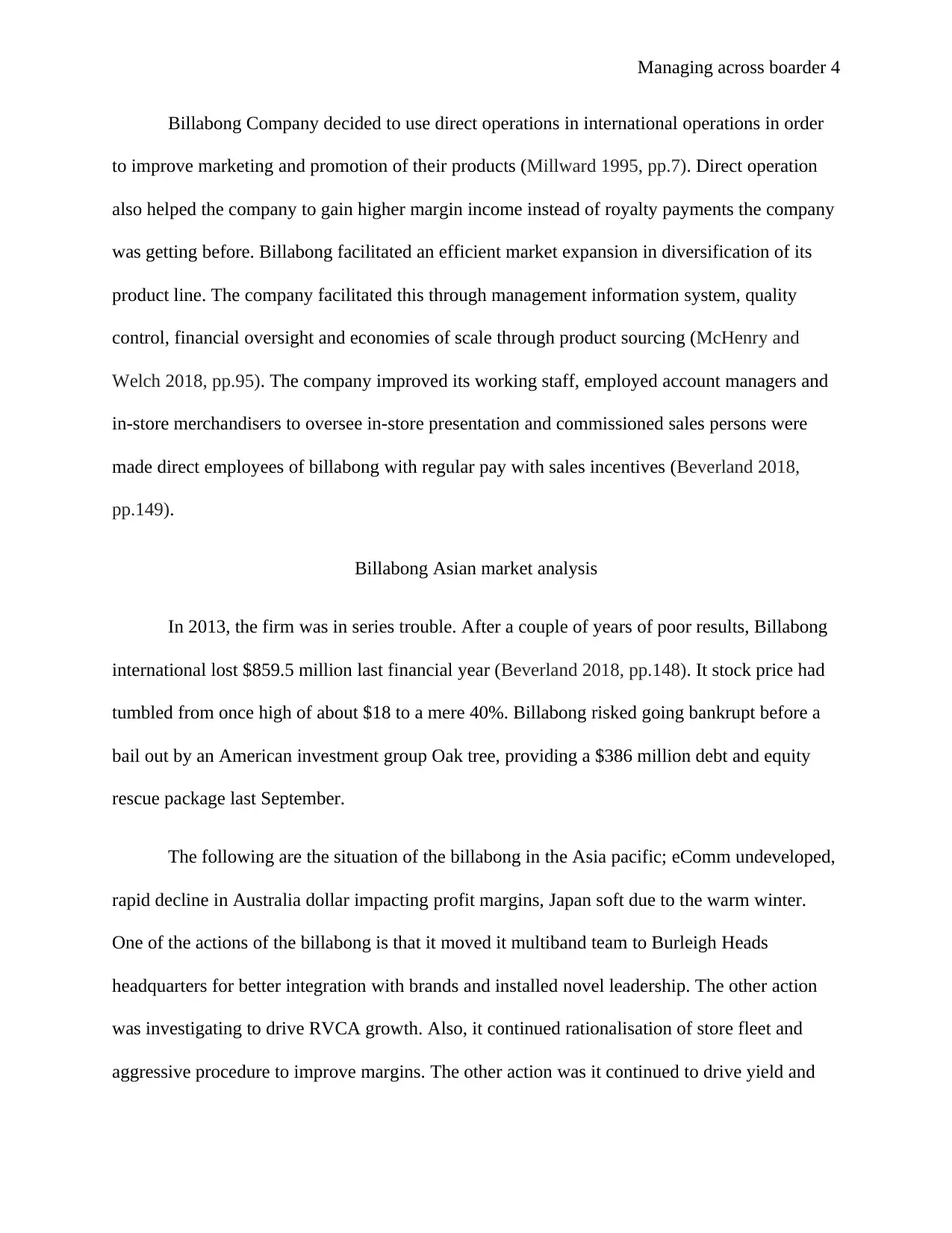
Managing across boarder 4
Billabong Company decided to use direct operations in international operations in order
to improve marketing and promotion of their products (Millward 1995, pp.7). Direct operation
also helped the company to gain higher margin income instead of royalty payments the company
was getting before. Billabong facilitated an efficient market expansion in diversification of its
product line. The company facilitated this through management information system, quality
control, financial oversight and economies of scale through product sourcing (McHenry and
Welch 2018, pp.95). The company improved its working staff, employed account managers and
in-store merchandisers to oversee in-store presentation and commissioned sales persons were
made direct employees of billabong with regular pay with sales incentives (Beverland 2018,
pp.149).
Billabong Asian market analysis
In 2013, the firm was in series trouble. After a couple of years of poor results, Billabong
international lost $859.5 million last financial year (Beverland 2018, pp.148). It stock price had
tumbled from once high of about $18 to a mere 40%. Billabong risked going bankrupt before a
bail out by an American investment group Oak tree, providing a $386 million debt and equity
rescue package last September.
The following are the situation of the billabong in the Asia pacific; eComm undeveloped,
rapid decline in Australia dollar impacting profit margins, Japan soft due to the warm winter.
One of the actions of the billabong is that it moved it multiband team to Burleigh Heads
headquarters for better integration with brands and installed novel leadership. The other action
was investigating to drive RVCA growth. Also, it continued rationalisation of store fleet and
aggressive procedure to improve margins. The other action was it continued to drive yield and
Billabong Company decided to use direct operations in international operations in order
to improve marketing and promotion of their products (Millward 1995, pp.7). Direct operation
also helped the company to gain higher margin income instead of royalty payments the company
was getting before. Billabong facilitated an efficient market expansion in diversification of its
product line. The company facilitated this through management information system, quality
control, financial oversight and economies of scale through product sourcing (McHenry and
Welch 2018, pp.95). The company improved its working staff, employed account managers and
in-store merchandisers to oversee in-store presentation and commissioned sales persons were
made direct employees of billabong with regular pay with sales incentives (Beverland 2018,
pp.149).
Billabong Asian market analysis
In 2013, the firm was in series trouble. After a couple of years of poor results, Billabong
international lost $859.5 million last financial year (Beverland 2018, pp.148). It stock price had
tumbled from once high of about $18 to a mere 40%. Billabong risked going bankrupt before a
bail out by an American investment group Oak tree, providing a $386 million debt and equity
rescue package last September.
The following are the situation of the billabong in the Asia pacific; eComm undeveloped,
rapid decline in Australia dollar impacting profit margins, Japan soft due to the warm winter.
One of the actions of the billabong is that it moved it multiband team to Burleigh Heads
headquarters for better integration with brands and installed novel leadership. The other action
was investigating to drive RVCA growth. Also, it continued rationalisation of store fleet and
aggressive procedure to improve margins. The other action was it continued to drive yield and
Paraphrase This Document
Need a fresh take? Get an instant paraphrase of this document with our AI Paraphraser
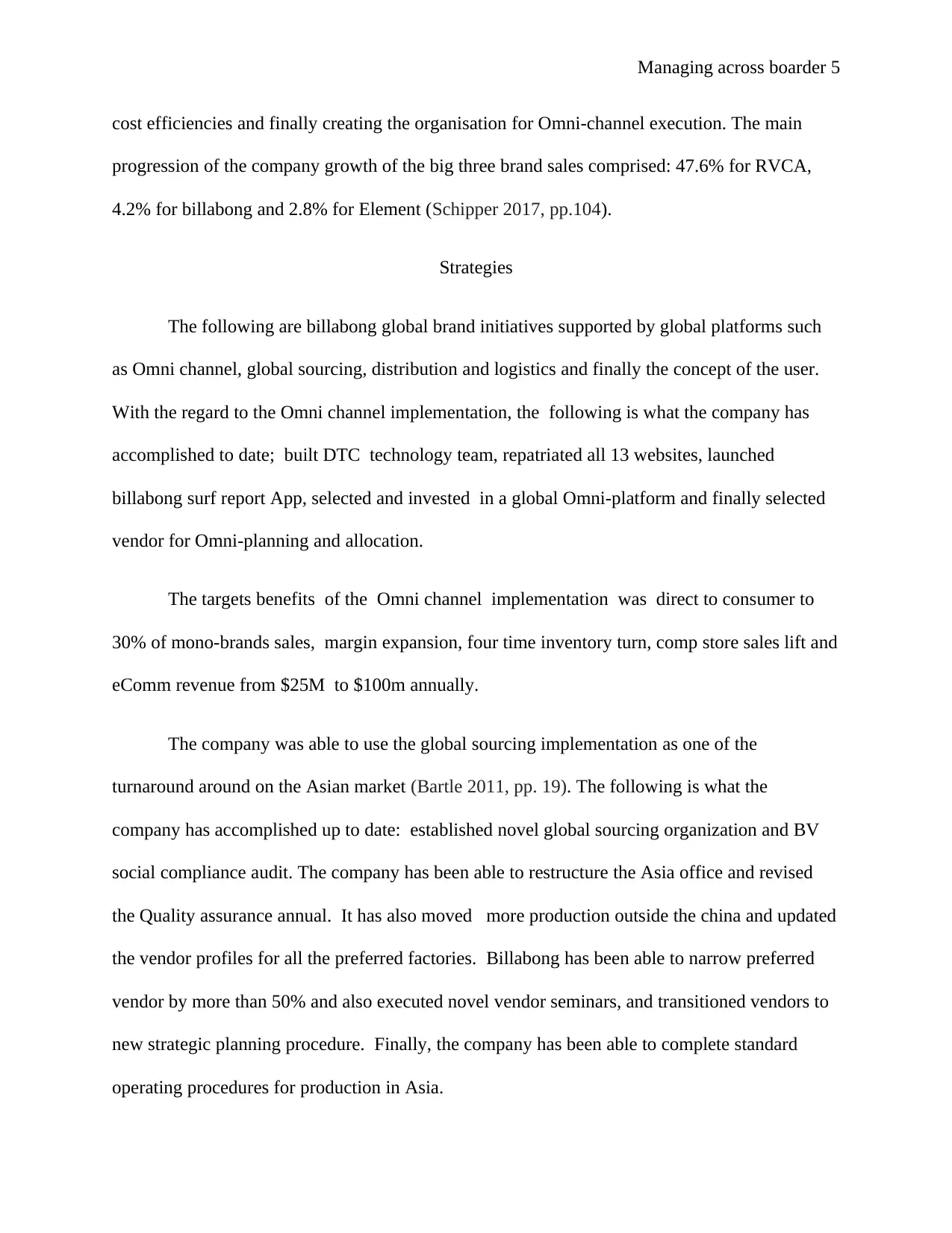
Managing across boarder 5
cost efficiencies and finally creating the organisation for Omni-channel execution. The main
progression of the company growth of the big three brand sales comprised: 47.6% for RVCA,
4.2% for billabong and 2.8% for Element (Schipper 2017, pp.104).
Strategies
The following are billabong global brand initiatives supported by global platforms such
as Omni channel, global sourcing, distribution and logistics and finally the concept of the user.
With the regard to the Omni channel implementation, the following is what the company has
accomplished to date; built DTC technology team, repatriated all 13 websites, launched
billabong surf report App, selected and invested in a global Omni-platform and finally selected
vendor for Omni-planning and allocation.
The targets benefits of the Omni channel implementation was direct to consumer to
30% of mono-brands sales, margin expansion, four time inventory turn, comp store sales lift and
eComm revenue from $25M to $100m annually.
The company was able to use the global sourcing implementation as one of the
turnaround around on the Asian market (Bartle 2011, pp. 19). The following is what the
company has accomplished up to date: established novel global sourcing organization and BV
social compliance audit. The company has been able to restructure the Asia office and revised
the Quality assurance annual. It has also moved more production outside the china and updated
the vendor profiles for all the preferred factories. Billabong has been able to narrow preferred
vendor by more than 50% and also executed novel vendor seminars, and transitioned vendors to
new strategic planning procedure. Finally, the company has been able to complete standard
operating procedures for production in Asia.
cost efficiencies and finally creating the organisation for Omni-channel execution. The main
progression of the company growth of the big three brand sales comprised: 47.6% for RVCA,
4.2% for billabong and 2.8% for Element (Schipper 2017, pp.104).
Strategies
The following are billabong global brand initiatives supported by global platforms such
as Omni channel, global sourcing, distribution and logistics and finally the concept of the user.
With the regard to the Omni channel implementation, the following is what the company has
accomplished to date; built DTC technology team, repatriated all 13 websites, launched
billabong surf report App, selected and invested in a global Omni-platform and finally selected
vendor for Omni-planning and allocation.
The targets benefits of the Omni channel implementation was direct to consumer to
30% of mono-brands sales, margin expansion, four time inventory turn, comp store sales lift and
eComm revenue from $25M to $100m annually.
The company was able to use the global sourcing implementation as one of the
turnaround around on the Asian market (Bartle 2011, pp. 19). The following is what the
company has accomplished up to date: established novel global sourcing organization and BV
social compliance audit. The company has been able to restructure the Asia office and revised
the Quality assurance annual. It has also moved more production outside the china and updated
the vendor profiles for all the preferred factories. Billabong has been able to narrow preferred
vendor by more than 50% and also executed novel vendor seminars, and transitioned vendors to
new strategic planning procedure. Finally, the company has been able to complete standard
operating procedures for production in Asia.
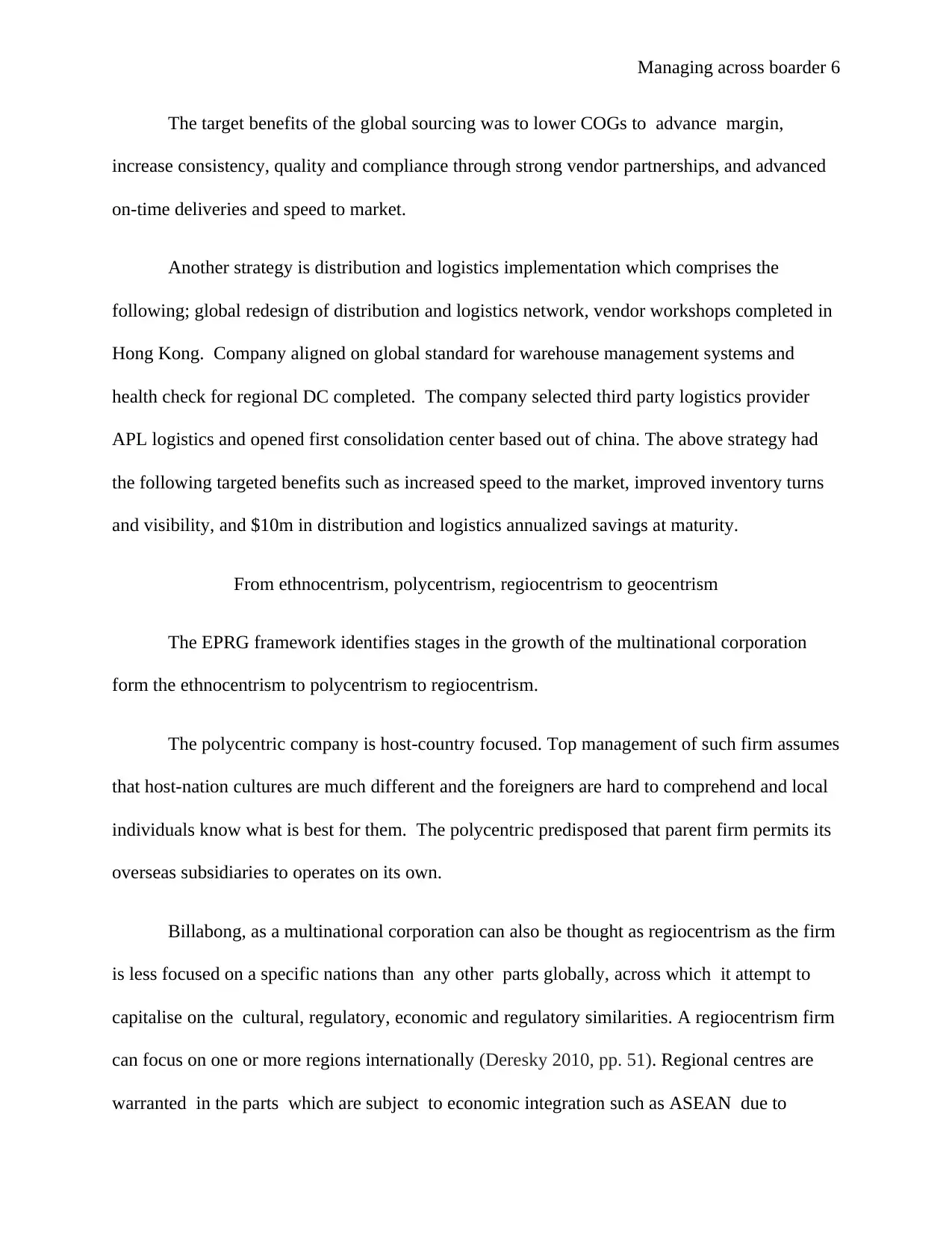
Managing across boarder 6
The target benefits of the global sourcing was to lower COGs to advance margin,
increase consistency, quality and compliance through strong vendor partnerships, and advanced
on-time deliveries and speed to market.
Another strategy is distribution and logistics implementation which comprises the
following; global redesign of distribution and logistics network, vendor workshops completed in
Hong Kong. Company aligned on global standard for warehouse management systems and
health check for regional DC completed. The company selected third party logistics provider
APL logistics and opened first consolidation center based out of china. The above strategy had
the following targeted benefits such as increased speed to the market, improved inventory turns
and visibility, and $10m in distribution and logistics annualized savings at maturity.
From ethnocentrism, polycentrism, regiocentrism to geocentrism
The EPRG framework identifies stages in the growth of the multinational corporation
form the ethnocentrism to polycentrism to regiocentrism.
The polycentric company is host-country focused. Top management of such firm assumes
that host-nation cultures are much different and the foreigners are hard to comprehend and local
individuals know what is best for them. The polycentric predisposed that parent firm permits its
overseas subsidiaries to operates on its own.
Billabong, as a multinational corporation can also be thought as regiocentrism as the firm
is less focused on a specific nations than any other parts globally, across which it attempt to
capitalise on the cultural, regulatory, economic and regulatory similarities. A regiocentrism firm
can focus on one or more regions internationally (Deresky 2010, pp. 51). Regional centres are
warranted in the parts which are subject to economic integration such as ASEAN due to
The target benefits of the global sourcing was to lower COGs to advance margin,
increase consistency, quality and compliance through strong vendor partnerships, and advanced
on-time deliveries and speed to market.
Another strategy is distribution and logistics implementation which comprises the
following; global redesign of distribution and logistics network, vendor workshops completed in
Hong Kong. Company aligned on global standard for warehouse management systems and
health check for regional DC completed. The company selected third party logistics provider
APL logistics and opened first consolidation center based out of china. The above strategy had
the following targeted benefits such as increased speed to the market, improved inventory turns
and visibility, and $10m in distribution and logistics annualized savings at maturity.
From ethnocentrism, polycentrism, regiocentrism to geocentrism
The EPRG framework identifies stages in the growth of the multinational corporation
form the ethnocentrism to polycentrism to regiocentrism.
The polycentric company is host-country focused. Top management of such firm assumes
that host-nation cultures are much different and the foreigners are hard to comprehend and local
individuals know what is best for them. The polycentric predisposed that parent firm permits its
overseas subsidiaries to operates on its own.
Billabong, as a multinational corporation can also be thought as regiocentrism as the firm
is less focused on a specific nations than any other parts globally, across which it attempt to
capitalise on the cultural, regulatory, economic and regulatory similarities. A regiocentrism firm
can focus on one or more regions internationally (Deresky 2010, pp. 51). Regional centres are
warranted in the parts which are subject to economic integration such as ASEAN due to
⊘ This is a preview!⊘
Do you want full access?
Subscribe today to unlock all pages.

Trusted by 1+ million students worldwide
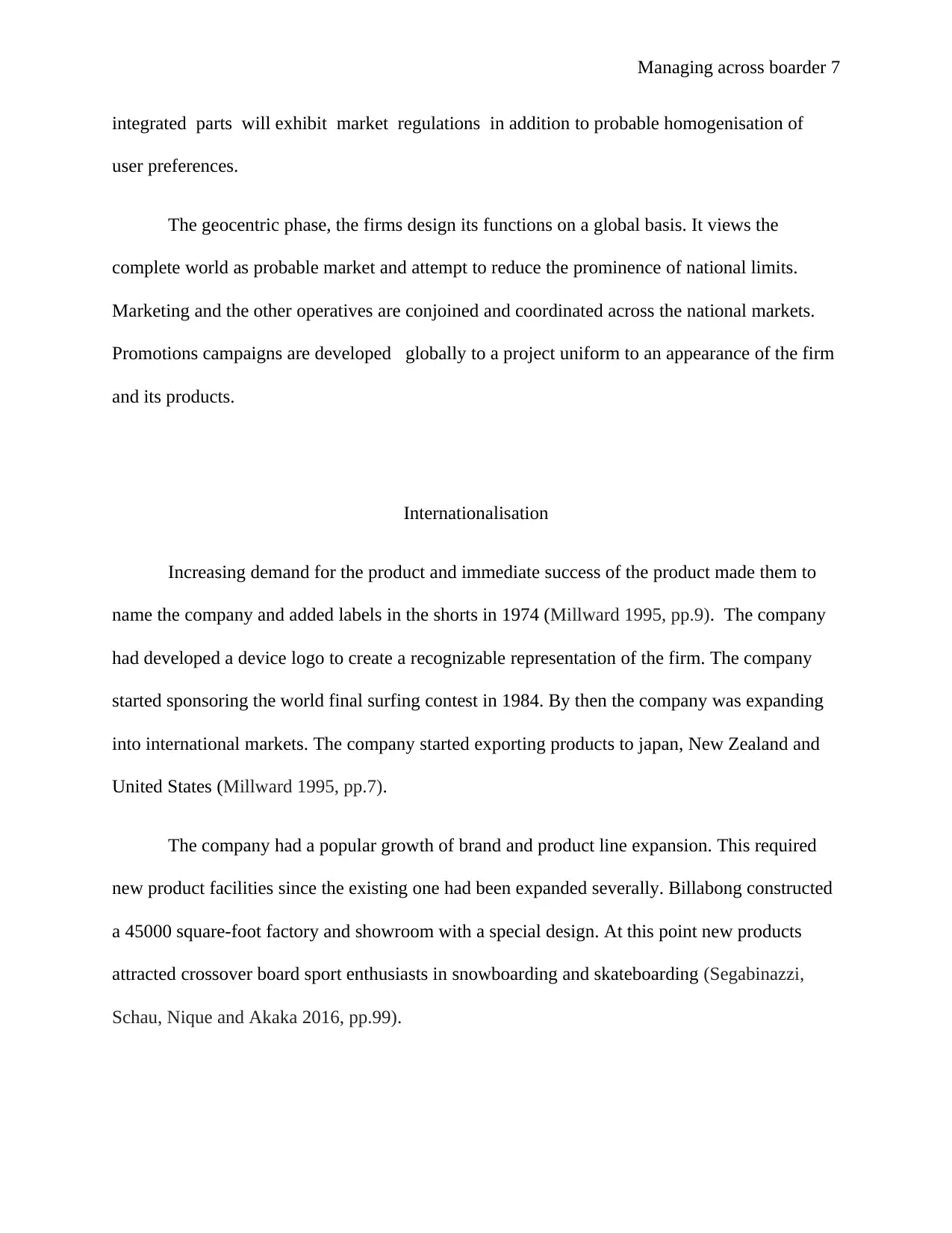
Managing across boarder 7
integrated parts will exhibit market regulations in addition to probable homogenisation of
user preferences.
The geocentric phase, the firms design its functions on a global basis. It views the
complete world as probable market and attempt to reduce the prominence of national limits.
Marketing and the other operatives are conjoined and coordinated across the national markets.
Promotions campaigns are developed globally to a project uniform to an appearance of the firm
and its products.
Internationalisation
Increasing demand for the product and immediate success of the product made them to
name the company and added labels in the shorts in 1974 (Millward 1995, pp.9). The company
had developed a device logo to create a recognizable representation of the firm. The company
started sponsoring the world final surfing contest in 1984. By then the company was expanding
into international markets. The company started exporting products to japan, New Zealand and
United States (Millward 1995, pp.7).
The company had a popular growth of brand and product line expansion. This required
new product facilities since the existing one had been expanded severally. Billabong constructed
a 45000 square-foot factory and showroom with a special design. At this point new products
attracted crossover board sport enthusiasts in snowboarding and skateboarding (Segabinazzi,
Schau, Nique and Akaka 2016, pp.99).
integrated parts will exhibit market regulations in addition to probable homogenisation of
user preferences.
The geocentric phase, the firms design its functions on a global basis. It views the
complete world as probable market and attempt to reduce the prominence of national limits.
Marketing and the other operatives are conjoined and coordinated across the national markets.
Promotions campaigns are developed globally to a project uniform to an appearance of the firm
and its products.
Internationalisation
Increasing demand for the product and immediate success of the product made them to
name the company and added labels in the shorts in 1974 (Millward 1995, pp.9). The company
had developed a device logo to create a recognizable representation of the firm. The company
started sponsoring the world final surfing contest in 1984. By then the company was expanding
into international markets. The company started exporting products to japan, New Zealand and
United States (Millward 1995, pp.7).
The company had a popular growth of brand and product line expansion. This required
new product facilities since the existing one had been expanded severally. Billabong constructed
a 45000 square-foot factory and showroom with a special design. At this point new products
attracted crossover board sport enthusiasts in snowboarding and skateboarding (Segabinazzi,
Schau, Nique and Akaka 2016, pp.99).
Paraphrase This Document
Need a fresh take? Get an instant paraphrase of this document with our AI Paraphraser
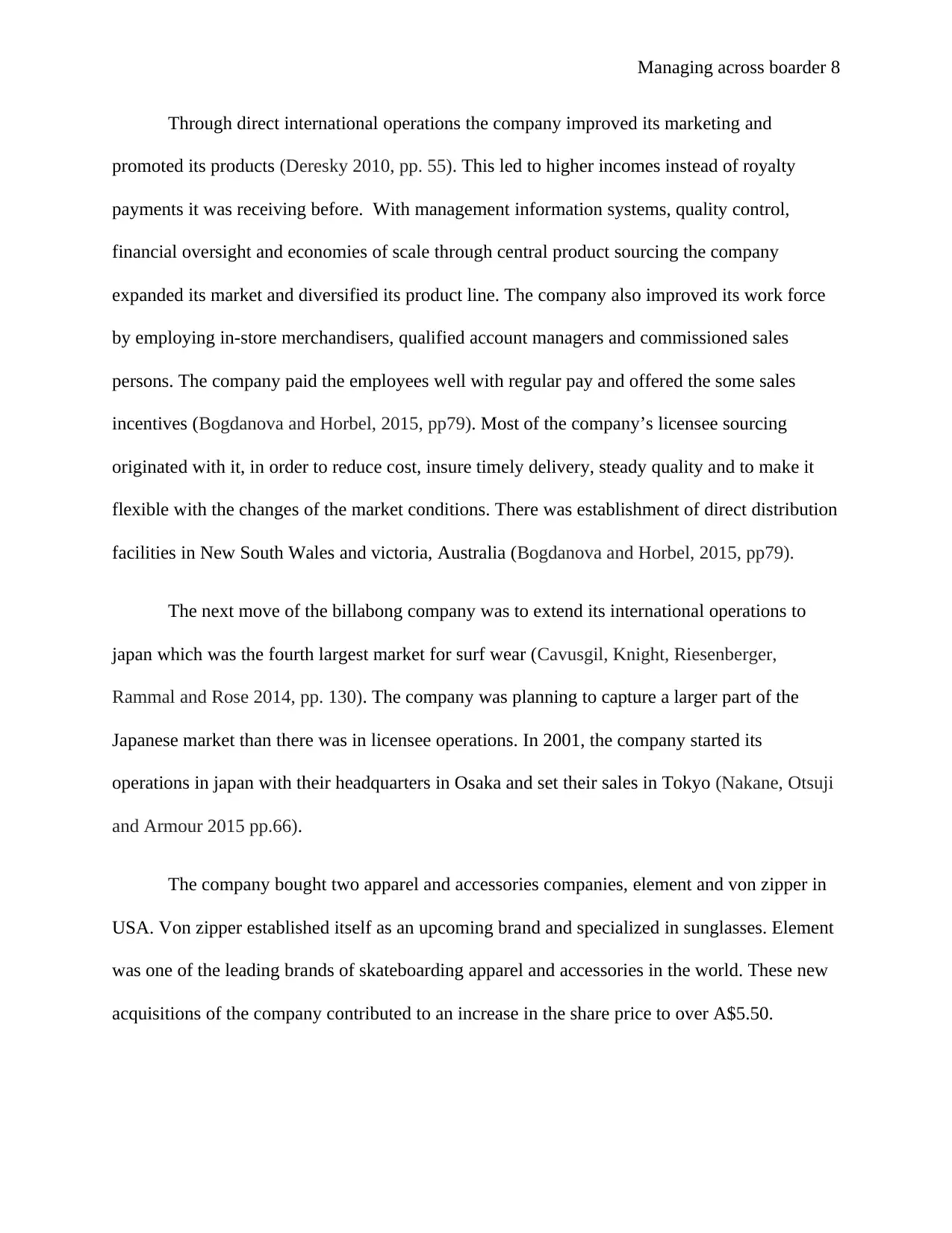
Managing across boarder 8
Through direct international operations the company improved its marketing and
promoted its products (Deresky 2010, pp. 55). This led to higher incomes instead of royalty
payments it was receiving before. With management information systems, quality control,
financial oversight and economies of scale through central product sourcing the company
expanded its market and diversified its product line. The company also improved its work force
by employing in-store merchandisers, qualified account managers and commissioned sales
persons. The company paid the employees well with regular pay and offered the some sales
incentives (Bogdanova and Horbel, 2015, pp79). Most of the company’s licensee sourcing
originated with it, in order to reduce cost, insure timely delivery, steady quality and to make it
flexible with the changes of the market conditions. There was establishment of direct distribution
facilities in New South Wales and victoria, Australia (Bogdanova and Horbel, 2015, pp79).
The next move of the billabong company was to extend its international operations to
japan which was the fourth largest market for surf wear (Cavusgil, Knight, Riesenberger,
Rammal and Rose 2014, pp. 130). The company was planning to capture a larger part of the
Japanese market than there was in licensee operations. In 2001, the company started its
operations in japan with their headquarters in Osaka and set their sales in Tokyo (Nakane, Otsuji
and Armour 2015 pp.66).
The company bought two apparel and accessories companies, element and von zipper in
USA. Von zipper established itself as an upcoming brand and specialized in sunglasses. Element
was one of the leading brands of skateboarding apparel and accessories in the world. These new
acquisitions of the company contributed to an increase in the share price to over A$5.50.
Through direct international operations the company improved its marketing and
promoted its products (Deresky 2010, pp. 55). This led to higher incomes instead of royalty
payments it was receiving before. With management information systems, quality control,
financial oversight and economies of scale through central product sourcing the company
expanded its market and diversified its product line. The company also improved its work force
by employing in-store merchandisers, qualified account managers and commissioned sales
persons. The company paid the employees well with regular pay and offered the some sales
incentives (Bogdanova and Horbel, 2015, pp79). Most of the company’s licensee sourcing
originated with it, in order to reduce cost, insure timely delivery, steady quality and to make it
flexible with the changes of the market conditions. There was establishment of direct distribution
facilities in New South Wales and victoria, Australia (Bogdanova and Horbel, 2015, pp79).
The next move of the billabong company was to extend its international operations to
japan which was the fourth largest market for surf wear (Cavusgil, Knight, Riesenberger,
Rammal and Rose 2014, pp. 130). The company was planning to capture a larger part of the
Japanese market than there was in licensee operations. In 2001, the company started its
operations in japan with their headquarters in Osaka and set their sales in Tokyo (Nakane, Otsuji
and Armour 2015 pp.66).
The company bought two apparel and accessories companies, element and von zipper in
USA. Von zipper established itself as an upcoming brand and specialized in sunglasses. Element
was one of the leading brands of skateboarding apparel and accessories in the world. These new
acquisitions of the company contributed to an increase in the share price to over A$5.50.
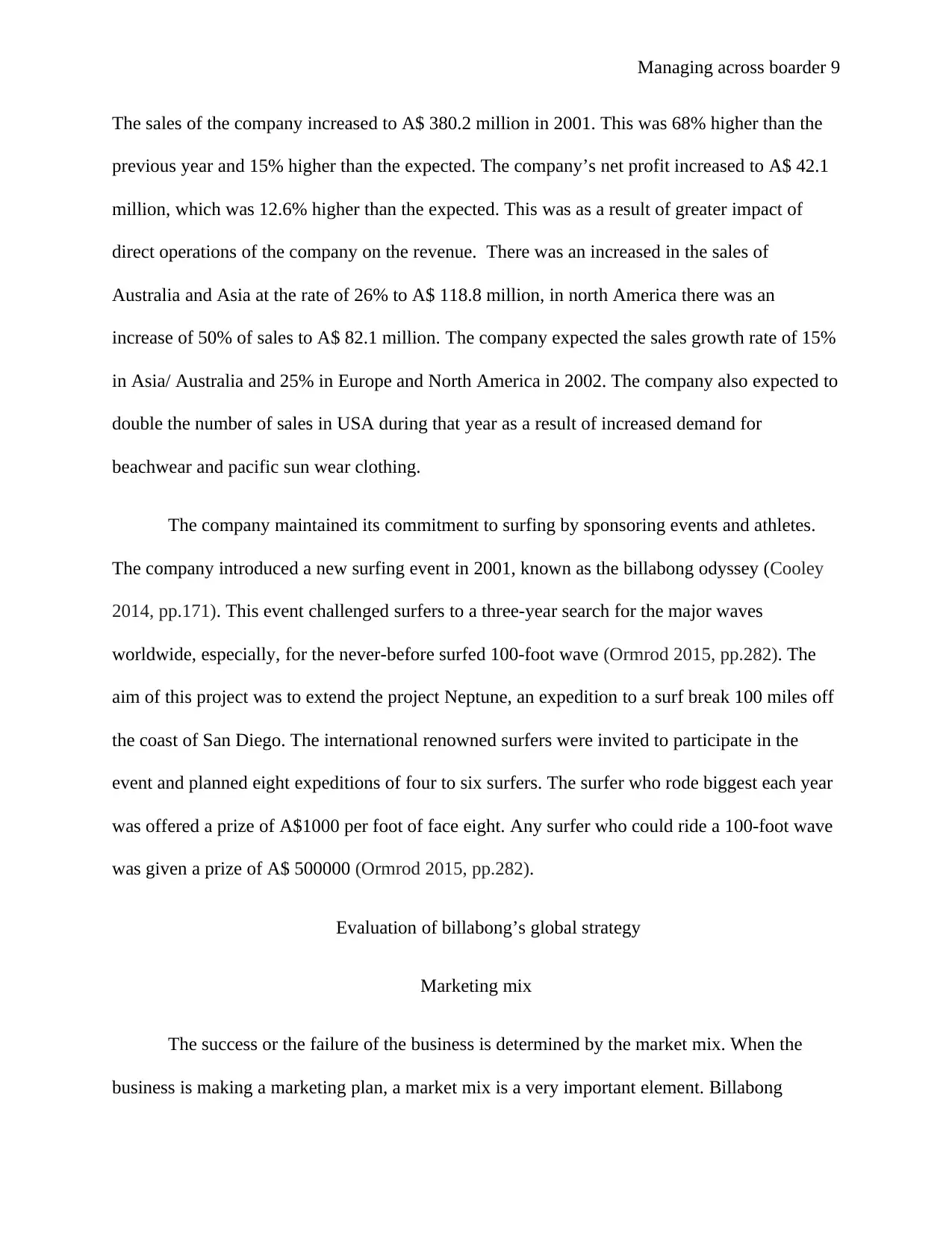
Managing across boarder 9
The sales of the company increased to A$ 380.2 million in 2001. This was 68% higher than the
previous year and 15% higher than the expected. The company’s net profit increased to A$ 42.1
million, which was 12.6% higher than the expected. This was as a result of greater impact of
direct operations of the company on the revenue. There was an increased in the sales of
Australia and Asia at the rate of 26% to A$ 118.8 million, in north America there was an
increase of 50% of sales to A$ 82.1 million. The company expected the sales growth rate of 15%
in Asia/ Australia and 25% in Europe and North America in 2002. The company also expected to
double the number of sales in USA during that year as a result of increased demand for
beachwear and pacific sun wear clothing.
The company maintained its commitment to surfing by sponsoring events and athletes.
The company introduced a new surfing event in 2001, known as the billabong odyssey (Cooley
2014, pp.171). This event challenged surfers to a three-year search for the major waves
worldwide, especially, for the never-before surfed 100-foot wave (Ormrod 2015, pp.282). The
aim of this project was to extend the project Neptune, an expedition to a surf break 100 miles off
the coast of San Diego. The international renowned surfers were invited to participate in the
event and planned eight expeditions of four to six surfers. The surfer who rode biggest each year
was offered a prize of A$1000 per foot of face eight. Any surfer who could ride a 100-foot wave
was given a prize of A$ 500000 (Ormrod 2015, pp.282).
Evaluation of billabong’s global strategy
Marketing mix
The success or the failure of the business is determined by the market mix. When the
business is making a marketing plan, a market mix is a very important element. Billabong
The sales of the company increased to A$ 380.2 million in 2001. This was 68% higher than the
previous year and 15% higher than the expected. The company’s net profit increased to A$ 42.1
million, which was 12.6% higher than the expected. This was as a result of greater impact of
direct operations of the company on the revenue. There was an increased in the sales of
Australia and Asia at the rate of 26% to A$ 118.8 million, in north America there was an
increase of 50% of sales to A$ 82.1 million. The company expected the sales growth rate of 15%
in Asia/ Australia and 25% in Europe and North America in 2002. The company also expected to
double the number of sales in USA during that year as a result of increased demand for
beachwear and pacific sun wear clothing.
The company maintained its commitment to surfing by sponsoring events and athletes.
The company introduced a new surfing event in 2001, known as the billabong odyssey (Cooley
2014, pp.171). This event challenged surfers to a three-year search for the major waves
worldwide, especially, for the never-before surfed 100-foot wave (Ormrod 2015, pp.282). The
aim of this project was to extend the project Neptune, an expedition to a surf break 100 miles off
the coast of San Diego. The international renowned surfers were invited to participate in the
event and planned eight expeditions of four to six surfers. The surfer who rode biggest each year
was offered a prize of A$1000 per foot of face eight. Any surfer who could ride a 100-foot wave
was given a prize of A$ 500000 (Ormrod 2015, pp.282).
Evaluation of billabong’s global strategy
Marketing mix
The success or the failure of the business is determined by the market mix. When the
business is making a marketing plan, a market mix is a very important element. Billabong
⊘ This is a preview!⊘
Do you want full access?
Subscribe today to unlock all pages.

Trusted by 1+ million students worldwide
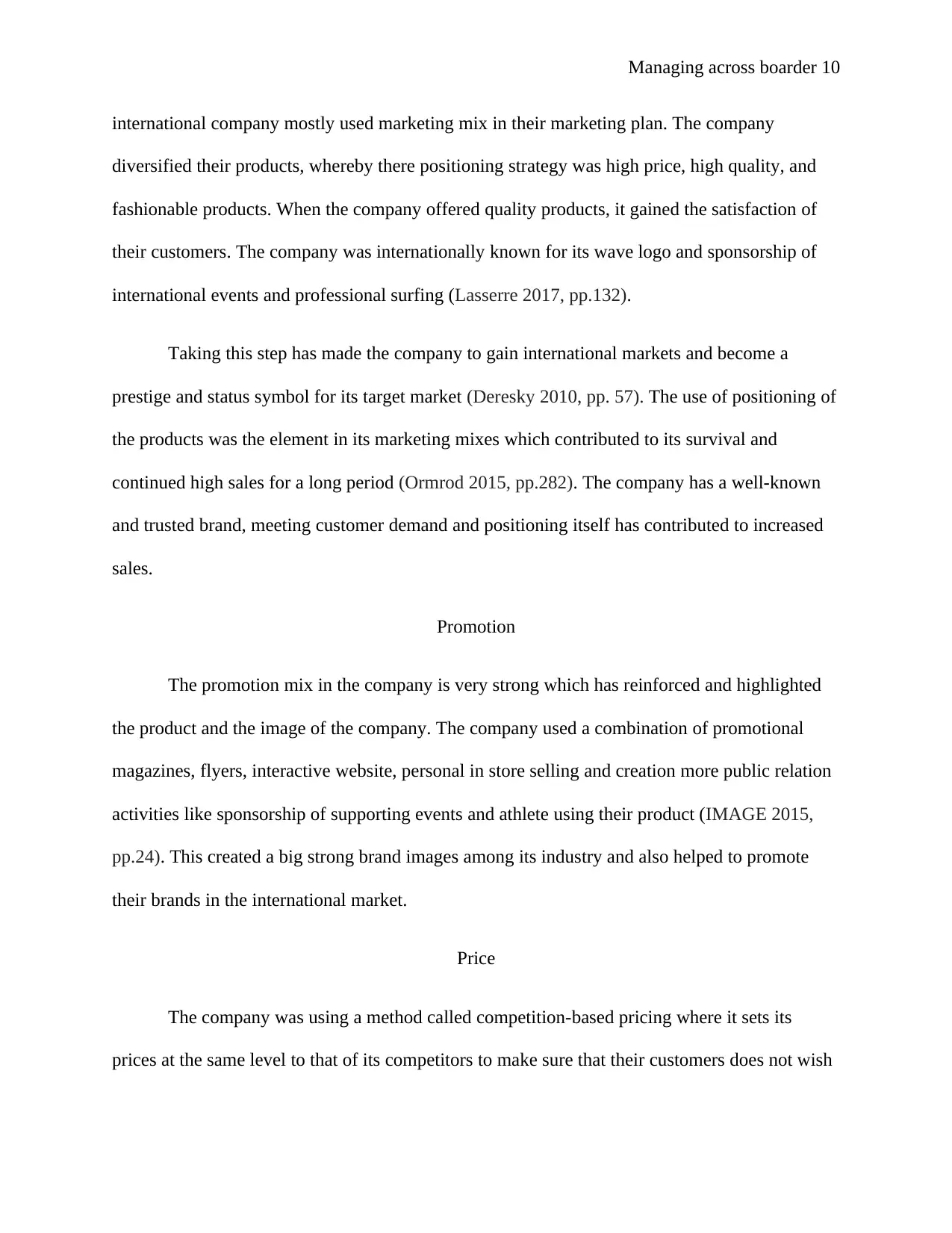
Managing across boarder 10
international company mostly used marketing mix in their marketing plan. The company
diversified their products, whereby there positioning strategy was high price, high quality, and
fashionable products. When the company offered quality products, it gained the satisfaction of
their customers. The company was internationally known for its wave logo and sponsorship of
international events and professional surfing (Lasserre 2017, pp.132).
Taking this step has made the company to gain international markets and become a
prestige and status symbol for its target market (Deresky 2010, pp. 57). The use of positioning of
the products was the element in its marketing mixes which contributed to its survival and
continued high sales for a long period (Ormrod 2015, pp.282). The company has a well-known
and trusted brand, meeting customer demand and positioning itself has contributed to increased
sales.
Promotion
The promotion mix in the company is very strong which has reinforced and highlighted
the product and the image of the company. The company used a combination of promotional
magazines, flyers, interactive website, personal in store selling and creation more public relation
activities like sponsorship of supporting events and athlete using their product (IMAGE 2015,
pp.24). This created a big strong brand images among its industry and also helped to promote
their brands in the international market.
Price
The company was using a method called competition-based pricing where it sets its
prices at the same level to that of its competitors to make sure that their customers does not wish
international company mostly used marketing mix in their marketing plan. The company
diversified their products, whereby there positioning strategy was high price, high quality, and
fashionable products. When the company offered quality products, it gained the satisfaction of
their customers. The company was internationally known for its wave logo and sponsorship of
international events and professional surfing (Lasserre 2017, pp.132).
Taking this step has made the company to gain international markets and become a
prestige and status symbol for its target market (Deresky 2010, pp. 57). The use of positioning of
the products was the element in its marketing mixes which contributed to its survival and
continued high sales for a long period (Ormrod 2015, pp.282). The company has a well-known
and trusted brand, meeting customer demand and positioning itself has contributed to increased
sales.
Promotion
The promotion mix in the company is very strong which has reinforced and highlighted
the product and the image of the company. The company used a combination of promotional
magazines, flyers, interactive website, personal in store selling and creation more public relation
activities like sponsorship of supporting events and athlete using their product (IMAGE 2015,
pp.24). This created a big strong brand images among its industry and also helped to promote
their brands in the international market.
Price
The company was using a method called competition-based pricing where it sets its
prices at the same level to that of its competitors to make sure that their customers does not wish
Paraphrase This Document
Need a fresh take? Get an instant paraphrase of this document with our AI Paraphraser
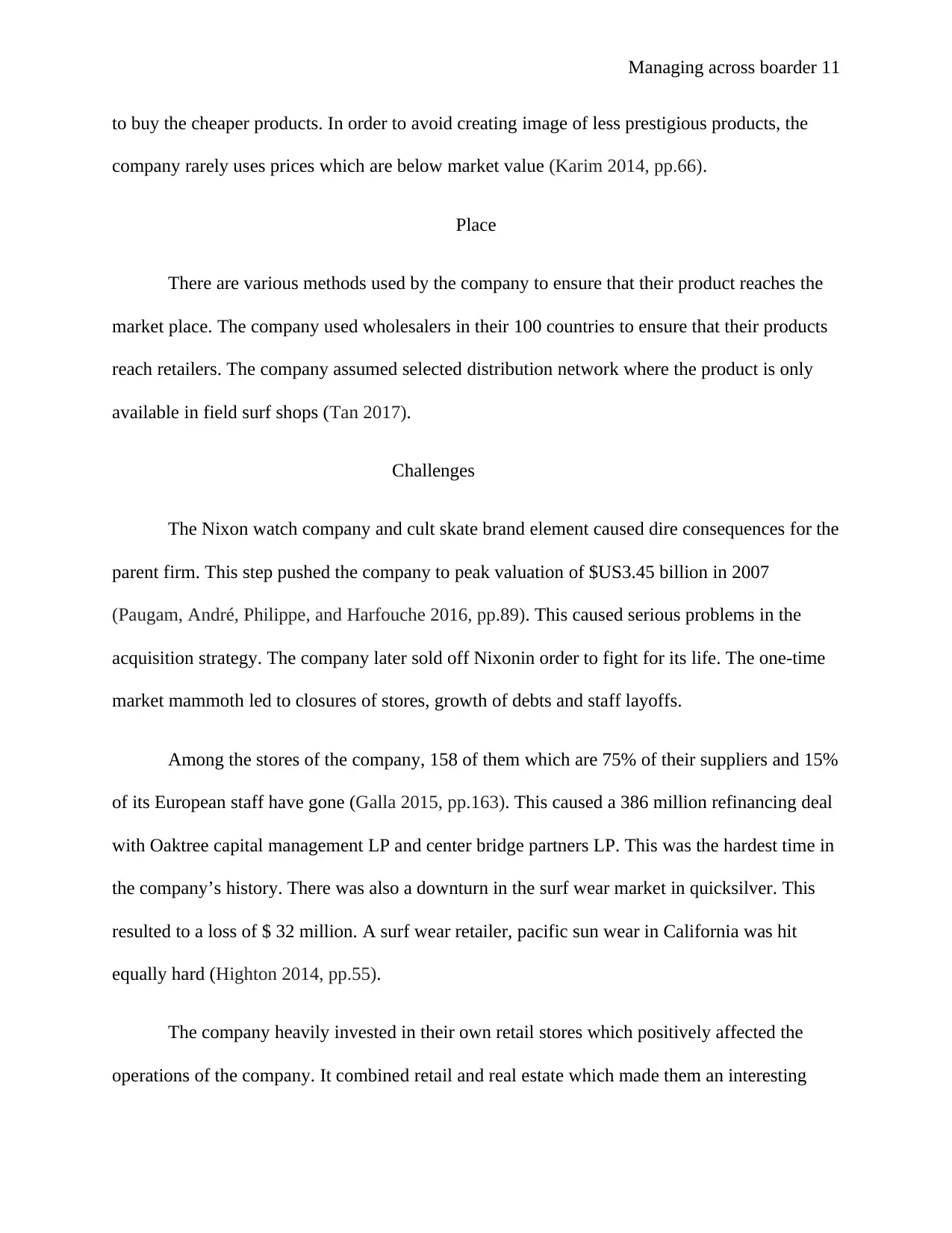
Managing across boarder 11
to buy the cheaper products. In order to avoid creating image of less prestigious products, the
company rarely uses prices which are below market value (Karim 2014, pp.66).
Place
There are various methods used by the company to ensure that their product reaches the
market place. The company used wholesalers in their 100 countries to ensure that their products
reach retailers. The company assumed selected distribution network where the product is only
available in field surf shops (Tan 2017).
Challenges
The Nixon watch company and cult skate brand element caused dire consequences for the
parent firm. This step pushed the company to peak valuation of $US3.45 billion in 2007
(Paugam, André, Philippe, and Harfouche 2016, pp.89). This caused serious problems in the
acquisition strategy. The company later sold off Nixonin order to fight for its life. The one-time
market mammoth led to closures of stores, growth of debts and staff layoffs.
Among the stores of the company, 158 of them which are 75% of their suppliers and 15%
of its European staff have gone (Galla 2015, pp.163). This caused a 386 million refinancing deal
with Oaktree capital management LP and center bridge partners LP. This was the hardest time in
the company’s history. There was also a downturn in the surf wear market in quicksilver. This
resulted to a loss of $ 32 million. A surf wear retailer, pacific sun wear in California was hit
equally hard (Highton 2014, pp.55).
The company heavily invested in their own retail stores which positively affected the
operations of the company. It combined retail and real estate which made them an interesting
to buy the cheaper products. In order to avoid creating image of less prestigious products, the
company rarely uses prices which are below market value (Karim 2014, pp.66).
Place
There are various methods used by the company to ensure that their product reaches the
market place. The company used wholesalers in their 100 countries to ensure that their products
reach retailers. The company assumed selected distribution network where the product is only
available in field surf shops (Tan 2017).
Challenges
The Nixon watch company and cult skate brand element caused dire consequences for the
parent firm. This step pushed the company to peak valuation of $US3.45 billion in 2007
(Paugam, André, Philippe, and Harfouche 2016, pp.89). This caused serious problems in the
acquisition strategy. The company later sold off Nixonin order to fight for its life. The one-time
market mammoth led to closures of stores, growth of debts and staff layoffs.
Among the stores of the company, 158 of them which are 75% of their suppliers and 15%
of its European staff have gone (Galla 2015, pp.163). This caused a 386 million refinancing deal
with Oaktree capital management LP and center bridge partners LP. This was the hardest time in
the company’s history. There was also a downturn in the surf wear market in quicksilver. This
resulted to a loss of $ 32 million. A surf wear retailer, pacific sun wear in California was hit
equally hard (Highton 2014, pp.55).
The company heavily invested in their own retail stores which positively affected the
operations of the company. It combined retail and real estate which made them an interesting
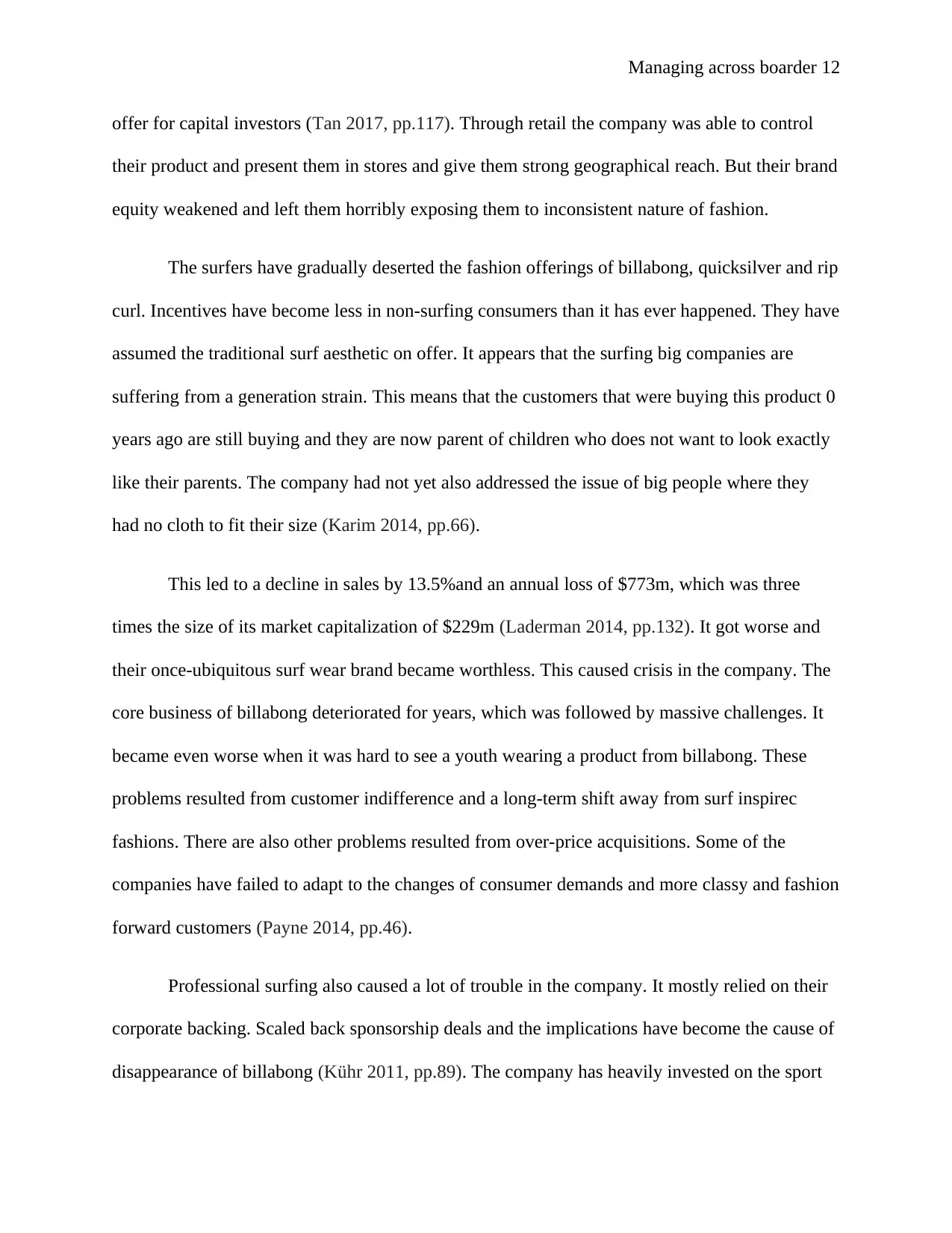
Managing across boarder 12
offer for capital investors (Tan 2017, pp.117). Through retail the company was able to control
their product and present them in stores and give them strong geographical reach. But their brand
equity weakened and left them horribly exposing them to inconsistent nature of fashion.
The surfers have gradually deserted the fashion offerings of billabong, quicksilver and rip
curl. Incentives have become less in non-surfing consumers than it has ever happened. They have
assumed the traditional surf aesthetic on offer. It appears that the surfing big companies are
suffering from a generation strain. This means that the customers that were buying this product 0
years ago are still buying and they are now parent of children who does not want to look exactly
like their parents. The company had not yet also addressed the issue of big people where they
had no cloth to fit their size (Karim 2014, pp.66).
This led to a decline in sales by 13.5%and an annual loss of $773m, which was three
times the size of its market capitalization of $229m (Laderman 2014, pp.132). It got worse and
their once-ubiquitous surf wear brand became worthless. This caused crisis in the company. The
core business of billabong deteriorated for years, which was followed by massive challenges. It
became even worse when it was hard to see a youth wearing a product from billabong. These
problems resulted from customer indifference and a long-term shift away from surf inspirec
fashions. There are also other problems resulted from over-price acquisitions. Some of the
companies have failed to adapt to the changes of consumer demands and more classy and fashion
forward customers (Payne 2014, pp.46).
Professional surfing also caused a lot of trouble in the company. It mostly relied on their
corporate backing. Scaled back sponsorship deals and the implications have become the cause of
disappearance of billabong (Kühr 2011, pp.89). The company has heavily invested on the sport
offer for capital investors (Tan 2017, pp.117). Through retail the company was able to control
their product and present them in stores and give them strong geographical reach. But their brand
equity weakened and left them horribly exposing them to inconsistent nature of fashion.
The surfers have gradually deserted the fashion offerings of billabong, quicksilver and rip
curl. Incentives have become less in non-surfing consumers than it has ever happened. They have
assumed the traditional surf aesthetic on offer. It appears that the surfing big companies are
suffering from a generation strain. This means that the customers that were buying this product 0
years ago are still buying and they are now parent of children who does not want to look exactly
like their parents. The company had not yet also addressed the issue of big people where they
had no cloth to fit their size (Karim 2014, pp.66).
This led to a decline in sales by 13.5%and an annual loss of $773m, which was three
times the size of its market capitalization of $229m (Laderman 2014, pp.132). It got worse and
their once-ubiquitous surf wear brand became worthless. This caused crisis in the company. The
core business of billabong deteriorated for years, which was followed by massive challenges. It
became even worse when it was hard to see a youth wearing a product from billabong. These
problems resulted from customer indifference and a long-term shift away from surf inspirec
fashions. There are also other problems resulted from over-price acquisitions. Some of the
companies have failed to adapt to the changes of consumer demands and more classy and fashion
forward customers (Payne 2014, pp.46).
Professional surfing also caused a lot of trouble in the company. It mostly relied on their
corporate backing. Scaled back sponsorship deals and the implications have become the cause of
disappearance of billabong (Kühr 2011, pp.89). The company has heavily invested on the sport
⊘ This is a preview!⊘
Do you want full access?
Subscribe today to unlock all pages.

Trusted by 1+ million students worldwide
1 out of 18
Related Documents
Your All-in-One AI-Powered Toolkit for Academic Success.
+13062052269
info@desklib.com
Available 24*7 on WhatsApp / Email
![[object Object]](/_next/static/media/star-bottom.7253800d.svg)
Unlock your academic potential
Copyright © 2020–2025 A2Z Services. All Rights Reserved. Developed and managed by ZUCOL.



